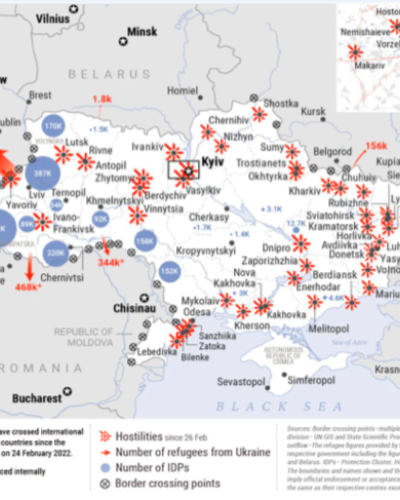Publication
Ukraine: Humanitarian Impact Situation Report as of 16 March 2022
17 March 2022

- As hostilities rage on, civilian casualties have risen to 1,900 as of 15 March – including 726 killed – according to the UN Office of the High Commissioner for Human Rights (OHCHR). These figures are likely much higher as reports are still being corroborated amid increasingly intense country-wide clashes.
- Since 15 March, the geographic scope of the hostilities has expanded to localities previously not directly affected. In Odeska oblast (south), the villages of Bilenke, Lebedivka, Sanzheika and Zatoka – all of which are located around 30 km south of the country’s third-largest city, Odesa – have been shelled. At the same time, Zaporizhzhia (Zaporizka oblast, south-east) has come under attack while people fleeing Mariupol (Donetska oblast, east) arrive in the city en masse.
- Nearly 4.9 million people have been forcibly displaced by the ongoing hostilities in Ukraine, including more than 3 million who have fled the country. Since 24 February, the UN Children’s Fund (UNICEF) says more than 1.5 million children have fled Ukraine – 75,000 on average per day. Abuse, sexual and gender-based violence (SGBV) and trafficking risks continue to mount amid wide-scale displacement.
- The socio-economic impacts of the ongoing hostilities threaten to reverse decades of hard-earned development and poverty reduction gains. The UN Development Programme (UNDP) projects that in the worst-case scenario – a deepening and protraction of ongoing hostilities – an alarming 90 per cent of the Ukrainian population could face poverty and extreme economic vulnerability.
- On 15 March, municipal authorities in Mariupol said around 20,000 people left the city ravaged by hostilities in approximately 4,000 private vehicles. Still, around 350,000-400,000 residents remain trapped in the city as critical supplies, including food, water and life-saving medicines, continue to dry up.
- As millions are now on the move, forced to shelter in crowded spaces with limited sanitation facilities and access to health services, the risk of infectious disease outbreaks, including COVID-19, cholera, polio, tuberculosis and diarrheal diseases, continues to rise.
Read full report here
Published by
OCHA




